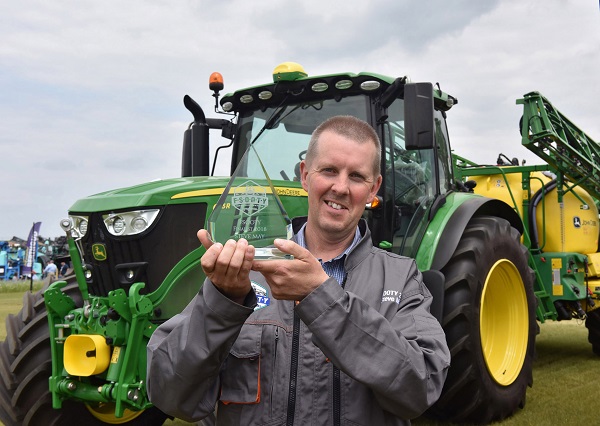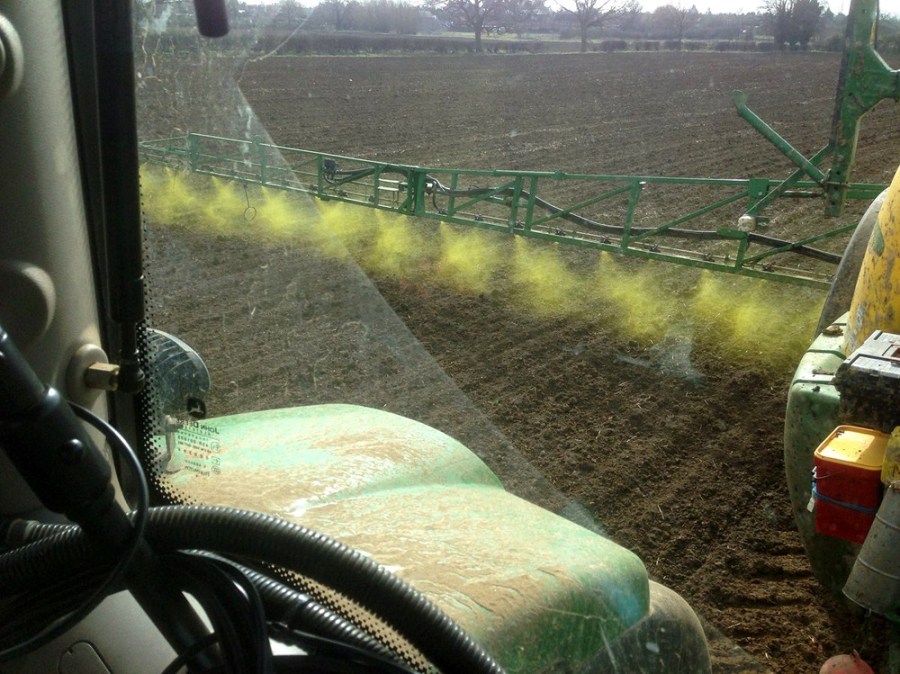Field conditions for applying pre-em herbicides can often be spot-on, only for the weather to limit spraying opportunities. CPM visits a user of nozzles designed to allow application across a wider wind speed range.
Coarser droplets from 90% drift-reducing air induction nozzles are very good at covering the soil surface target in an even manner.
By Martin Rickatson
The drilling’s done, the rain has held off, travel conditions look good and the sprayer is primed and ready for pre-emergence herbicide application. There’s only one factor holding back progress – the wind.
It’s an autumn scenario with which many combinable crop growers will be familiar. Building on a successful stale seedbed burn-off with a well-applied post-drilling pre-em spray is a core component of a successful grassweed control programme, especially for those with blackgrass issues.

With an expanding land area to cover, Steve May, finalist in the 2018 Farm Sprayer Operator of the Year competition, is keen to try new technologies.
But new nozzle technology can help to counter the effect of breezy conditions, and hence offer a wider spraying window and boost the chances of successful weed control results.
Air induction nozzles are based on the 110° wide angle, tapered flat spray tip pattern. There’s a large, rounded internal passage designed to minimise clogging risk and lengthen wear life, plus a removable pre-orifice.
Incorporating a venturi air aspirator into their design helps to produce large, air-filled droplets. Tests show these are less prone to drift and more likely to evenly coat the soil surface.
Calculated to reduce drift by as much as 90%, promotion of the nozzles’ use has formed an integral part of Syngenta’s ‘Go Low, Go Slow, Get Covered’ application advice campaign focused on helping users achieve successful results from its Defy (prosulfocarb) herbicide.
“Finer spray patterns have been one way some operators have traditionally tried to increase droplet numbers, but small droplets are inherently susceptible to drift, affecting product efficacy and reducing weed control, ultimately hitting yields and increasing the risk of resistance problems,” points out James Thomas, Syngenta application specialist.
“Dedicated application trials we’ve conducted, looking at interacting computations of boom height, forward speed, water volume and nozzle selection, show the value of the slogan we’ve adopted. That means a 50cm max boom height, a forward speed of less than 12km/h and a 200 l/ha water volume. Coupled with this type of 90% drift reduction nozzles, this provides the best coverage and minimises drift.
“Our trials work shows coarser droplets from 90% drift-reducing air induction nozzles are very good at covering the soil surface target in an even manner, and delivering exceptional levels of blackgrass control in very challenging situations with high weed and resistance pressure.”
Last autumn, Steve May, BASIS and FACTS-qualified arable foreman for Fromant and Sanders, based at Kislingbury, west of Northampton, fitted a set of low-drift nozzles to the 24m John Deere 740 trailed sprayer he uses across the 640ha the partnership farms on its own land and that of six contract customers. With all of that down to combinable crops, and a target to contain and reduce blackgrass populations, he was keen to try new nozzle technology to supplement his other strategies for maximising pre-emergence herbicide application efficacy.
One of six finalists in the 2018 Farm Sprayer Operator Of The Year competition, the area he looks after has increased steadily in recent years as contract land has been taken on. In an effort to ensure all land is covered at the ideal timing, he’s focused for some time on a series of factors to help him ensure pre-em grassweed control is as successful as possible, and as part of this last year he fitted his sprayer with 05 low-drift nozzles. In conjunction with water rates of 200 l/ha and forward speeds of no more than 10-12km/h, this, he says, allows him to apply pre-em herbicide even when wind speeds are at 2-5m/s.
“Where wind speed is ideal – less than 2m/s – I use 05 3D nozzles at 12km/h with a 200 l/ha water rate,” says Steve, who makes use of a weather app and weather station to keep abreast of potential changes and help him plan his spraying programme and strategy accordingly.
“But having five-way nozzle bodies means I can quickly select between nozzles. At any one time I usually have 05 3Ds and the low-drift ones for pre-em work, 025 Hypro nozzles for general tasks, 03 Defy nozzles and 03 Bubblejets.
“If the wind rises to anywhere in the 2-5m/s range that can affect the efficacy of the 3D nozzles, I can quickly switch round to the low-drift nozzles, then reduce forward speed and pressure slightly to carry on achieving a good soil application with minimal drift risk, keeping the boom at 50cm above the ground. That all helps to ensure the pre-ems go on at the right timing and we get the best results from them. I’ve conducted my own application tests which have shown what a difference the right nozzles for the conditions make to accuracy.”
Successful pre-em spraying is also about matching drilling and spraying capacity, he notes, and in order to keep on top of a farmed area that has grown steadily in recent years, a spraying workrate of 70-100ha/day is necessary to keep up with the drill and ensure spray timings are applied on time.
“While the distance between our different blocks of land isn’t too great, we do have a lot of relatively small fields, with an average size of around 6ha. That means folding booms in and out and travelling between fields can take up considerable time, as can negotiating in-field obstacles such as telegraph poles and trees.
“There’ also the fact that the land blocks are around 40-52ha each, and with our current sprayer being a 4000-litre model it generally holds only enough liquid for 20ha (50ac) when applying pre-ems at 200 l/ha water rates, meaning refills are necessary. Given that I’m the only full-time member of staff, running a bowser wouldn’t be easy, so a network of satellite tanks in strategic places is used to ensure refill time is kept to a minimum.”
The land area Steve covers continues to expand, with another 52ha taken on for this season. “I’m hoping we’ll upgrade to a 6000-litre machine when the existing sprayer comes due for renewal, and perhaps move from a 24m to a 36m boom and tramline system,” he notes.
“But with our current land and machinery in mind, and the need to get round fields faster, I try to make the most of all available daylight. To this end I’ve fitted LED lights to the spray boom to enable me to easily spot issues such as blocked nozzles during poor light when on early starts and late finishes. At only £120, they were one of the best investments I’ve made in accessories. Other small things also make a difference to speed of work, such as nozzle holders on which to place spare nozzles so they can be quickly and easily located should one need replacing.”
The low-drift nozzles were an extension of these other measures, he explains, and help to get the land covered, but they also have environmental benefits. “Pre-em applications can be particularly prone to the risk of drift as not only is there no crop to intercept the spray, but bare soils release stored heat, causing the air and spray to rise.
“Small spray droplets are particularly susceptible to spray drift. That not only reduces the efficacy of the applied product, but it also risks contamination of non-target areas. Crop protection chemistry is already under significant political and public pressure, so minimising residue detection through controlling drift is key to protecting products in the future.”
Steve aims to ensure that, rather than rushing to get crop in the ground once drilling commences, it’s carefully planned out so that only the area that can be comfortably sprayed within the coming weather window is drilled at any one time. He also ensures that pre-em herbicide, like any other product, is ordered and on farm well before it’s required.
“The first stage in my grassweed control strategy is to aim for as many stale seedbeds as I can achieve between harvest and drilling, targeting strong weed flushes each time. If the weather and the soils are especially dry, though, I’ll hold off from stale or actual seedbed creation,” he states.
“A dry seedbed is no good for either the crop or the weed control it requires, and if it’s too dry I’ll wait in either case. I’d rather hold off drilling altogether if conditions are too dry – or too wet – in the autumn, switch to a spring crop instead and save the winter seed for a year. It’s always important to have a back-up plan.”
Drilling is held back as late as comfortably possible, he continues, bearing in mind area to cover, drilling capacity and the risk of the weather turning, the later it gets into the autumn. “It’s then a matter of judging the soil conditions and the weather forecast before getting the pre-em herbicide on at the right time. It needs to be applied as soon as possible after drilling, but only if the weather and soil conditions are right.
“Providing the wind speed is within that 2-5m/s band, the selection of nozzles I have enable me to begin or to finish the job in conditions where the limitations of conventional nozzles would prevent me from getting underway or I’d have to stop spraying. During summer/autumn 2018, weather conditions were ideal for pre-em spraying, and given that harvest went so well bringing us two weeks ahead of schedule, we weren’t so pressured for time. But that could be very different another year, and anything that helps ease the spraying workload is welcome.”
Farm facts
Fromant and Sanders, Kislingbury, Northampton
- Cropped area: 640ha
- Soil type: Clay loam
- Staff: Steve May plus harvest casual
- Cropping: Winter wheat, spring barley, winter oats, winter oilseed rape, winter beans
- Tractors: John Deere 6215R, 6930, Case IH Puma 215
- Combine: 9m Claas Lexion 580+
- Sprayer: 24m trailed John Deere 740
- Drill: 4m Horsch Pronto DC




